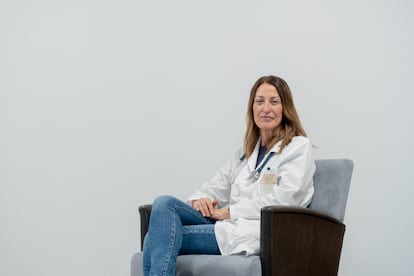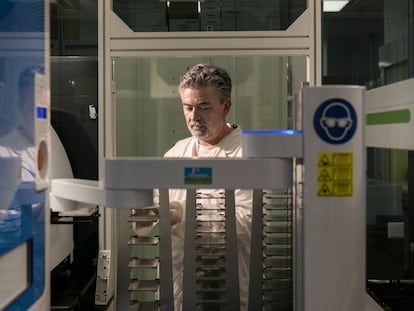Mar Castellanos, neurologist: ‘Stroke increasingly affects working-age people. Cardiovascular disease is an epidemic’
Cerebrovascular disease is the leading cause of female mortality in Spain, and the second in men: ‘The top reason is our lifestyle: poor diet, smoking, excess alcohol, sedentary lifestyle’

When Dr. Mar Castellanos chose to specialize in neurology, her exasperated physician colleagues asked, “Why neurology? Neurologists don’t cure anything.” Castellanos is coordinator of the Cerebrovascular Diseases Study Group of the Spanish Neurological Society (SEN), head of neurology at the University Hospital of A Coruña (CHUAC) in northwest Spain, and as of this year, director of the Institute for Biomedical Research of A Coruña (INIBIC). In a phone interview with EL PAÍS, Castellanos said, “Neurology has evolved immensely over the last 20 years. And we needed all that research because patients suffering from neurological conditions suffer from very disabling and deadly diseases, and often experience a great deal of suffering before dying.”
Q. Stroke is the leading cause of death in women in Spain, and the second leading cause in men. It’s the leading cause of disability in both women and men. Is this correct?
A. Yes. There has always been a perception that stroke is closely related to age, and that it happens mainly to older people. This used to be true, but no longer. More than 60% of stroke patients are younger than 65. Stroke is no longer an old person’s disease – it’s affecting more people of working age.
Q. Why is it increasingly affecting younger people?
A. Lifestyle. A sedentary lifestyle coupled with a poor diet and tobacco, alcohol, and drug consumption. One of the many problems resulting from the Covid pandemic is obesity in children linked to a poor diet and a lack of physical activity. Prolonged obesity is directly related to other risk factors such as arterial hypertension and diabetes, which become more severe when compounded with other risk factors.
Q And the body pays the price?
A. Cholesterol is an example. If we eat a lot of fatty foods, especially if they contain the bad fats that we’re told to avoid, we damage the arteries. They also cause artery calcifications and cholesterol plaques – called thrombi – that can break loose anytime. They travel through the circulatory system and block certain arteries, sometimes in the brain. Calcium and cholesterol deposits in the arteries also clog the artery itself – in the heart, brain, or legs.
Q. So we need regular check-ups.
A. Yes, and a healthy lifestyle. When it comes to combating strokes, we tend to focus on the acute phase. The patient must go to a hospital as quickly as possible so we can provide treatment. And many patients respond well to treatment. But we need to focus more on prevention. To avoid becoming stroke patients, we all need to heed medical recommendations and try to minimize the risk of vascular disease, which is at epidemic levels.
Q. We all have heard stories about the healthy, physically active person with no bad habits who suddenly suffers a stroke.
A. Of course, and there are many such stories. Even a young person who hasn’t developed any risk factors because of age can have a stroke. Why? There are a number of reasons, including genetics. Some diseases characteristically affect a specific gene or a certain genetic mutation. We all have genetic risk factors that we don’t know much about right now.
Q. Do we need more personalized medicine?
A. It is extremely important to raise public awareness so people will volunteer to participate in research studies. These enable us to collect a large volume of data that we need to develop algorithms that can better predict the type of patient at greater risk of suffering a stroke, and then try to prevent it.
Q. It’s a disease that causes panic when it hits close to home. It’s the closest thing to a sudden death.
A. It happens all of a sudden. A person can look and feel perfectly fine and two seconds later, he or she is no longer fine. Other diseases have symptoms that appear more gradually. Strokes happen so fast that response time is essential for survival and for avoiding permanent disability.
Q. So time is really important.
A. Time is of the essence. I place great emphasis on training people. Because recognizing the symptoms enables us to develop stroke plans with the objective of getting a patient to a medical center as quickly as possible. The brain’s recovery from a stroke and how much we can do for the patient depends on the amount time elapsed since the onset of symptoms. The longer the affected area lacks an adequate blood flow, the more likely those neurons will die.
Q. Physicians complain when someone with a minor ailment or who thinks they’re having a stroke goes to the emergency room, only to find out later that it’s nothing. The frustration of some physicians is understandable, but why should a patient have to recognize exactly what’s happening to him or her?
A. Our position is clear – go to the hospital as soon as possible if you suspect you’re having a stroke. It may have been a transient ischemic attack but because you feel fine now, you think nothing happened.
Q. What is that?
A. A transient ischemic attack or transient stroke is a warning of sorts. Even though you feel fine now, you should still go to an emergency room so that the neurologist can examine you and determine whether you have a high probability of recurrence. There are a number of tests that we can do, even in the emergency department, to determine whether a patient needs to remain in the hospital or can be discharged.
Q. What happens in the body during a transient stroke?
A. When a thrombus forms, the body initiates a series of mechanisms to break it up, such as hemostasis and coagulation. If I cut my hand with a knife, it will start to bleed. Since I’m healthy and have no problems with coagulation, the blood will stop flowing on its own. Why? Because the body begins producing more coagulation in that area to stop the bleeding. The opposite happens with a transient stroke. When the body detects a thrombus, it slows the coagulation process to a certain level and starts trying to dissolve the thrombus.
Tu suscripción se está usando en otro dispositivo
¿Quieres añadir otro usuario a tu suscripción?
Si continúas leyendo en este dispositivo, no se podrá leer en el otro.
FlechaTu suscripción se está usando en otro dispositivo y solo puedes acceder a EL PAÍS desde un dispositivo a la vez.
Si quieres compartir tu cuenta, cambia tu suscripción a la modalidad Premium, así podrás añadir otro usuario. Cada uno accederá con su propia cuenta de email, lo que os permitirá personalizar vuestra experiencia en EL PAÍS.
¿Tienes una suscripción de empresa? Accede aquí para contratar más cuentas.
En el caso de no saber quién está usando tu cuenta, te recomendamos cambiar tu contraseña aquí.
Si decides continuar compartiendo tu cuenta, este mensaje se mostrará en tu dispositivo y en el de la otra persona que está usando tu cuenta de forma indefinida, afectando a tu experiencia de lectura. Puedes consultar aquí los términos y condiciones de la suscripción digital.
More information
Últimas noticias
Maduro pleads not guilty before the federal court in New York: ‘I am still the president of Venezuela’
A new test can detect Alzheimer’s from a finger prick
UN team enters Sudanese city of El Fasher after paramilitary massacre: ‘It’s like a ghost town’
A recipe for resistance: Indigenous peoples politicize their struggles from the kitchen
Most viewed
- Gilles Lipovetsky: ‘If you want to live better and fall in love, take Prozac, don’t look to philosophy’
- Alain Aspect, Nobel laureate in physics: ‘Einstein was so smart that he would have had to recognize quantum entanglement’
- Alvin Hellerstein, a 92-year-old judge appointed by Bill Clinton, to preside over Maduro’s trial in New York
- Why oil has been at the center of Venezuela-US conflicts for decades
- Maduro’s downfall puts China’s relationship with Venezuela to the test











































